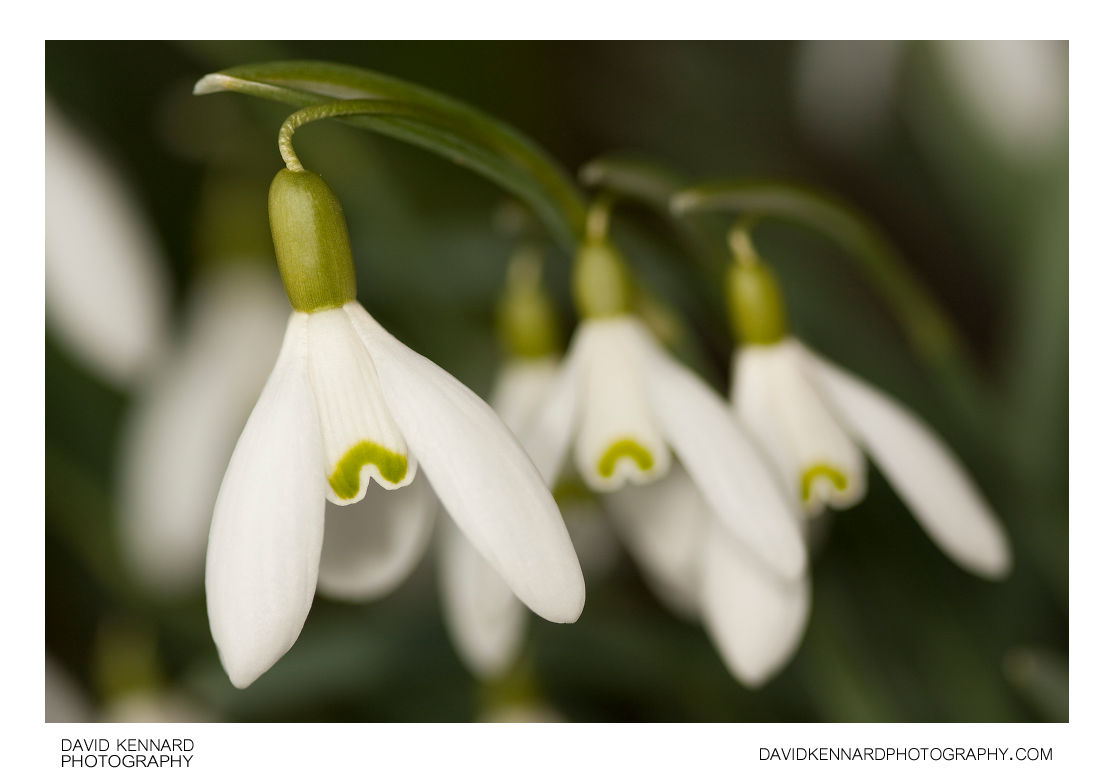Common Snowdrop flowers

Description
- Title:
- Common Snowdrop flowers
- Caption / Description:
-
Often referred to as the common snowdrop, Galanthus nivalis is the best-known and most widespread representative of a small genus of about 20 species in the family Amaryllidaceae. Snowdrops are among the first bulbs to bloom in spring and can form impressive carpets of white in areas where they are native or have been naturalised.
The generic name Galanthus, from the Greek gala (milk) and anthos (flower), was given to the genus by Carl Linnaeus in 1735. He described Galanthus nivalis in his Species Plantarum published in 1753. The epithet "nivalis" means "of the snow", referring either to the snow-like flower or the plant's early flowering.
The common name snowdrop first appeared in the 1633 edition of John Gerard's Great Herbal (in the first edition (1597) he described it as the "Timely flowring Bulbus violet"). The derivation of the name is uncertain, although it may have come from the German word Schneetropfen, which was a type of earring popular around that time. Other British traditional common names include "February fairmaids", "dingle-dangle", "Candlemas bells", "Mary's tapers" and, in parts of Yorkshire,"snow piercers" (like the French name perce-neige).
Galanthus nivalis is widely grown in gardens, particularly in northern Europe, and is widely naturalised in woodlands in the regions where it is grown. It is, however, native to a large area of Europe, from Spain in the west, eastwards to the Ukraine. It is found in Albania, Austria, Bulgaria, the Czech Republic, France, Georgia, Germany, Greece, Hungary, Italy, Poland, Moldova, Romania, Slovakia, Spain, Switzerland, Turkey, Ukraine and the former Yugoslavia.
Although often thought of as a British native wild flower, or to have been brought to the British Isles by the Romans, it is now thought that it was probably introduced much later, perhaps around the early sixteenth century.
Galanthus nivalis grows to around 7–15 cm tall, flowering between January and April in the northern temperate zone (January–May in the wild). They are perennial, herbaceous plants which grow from bulbs. Each bulb generally produces two linear, or very narrowly lanceolate, greyish-green leaves and an erect, leafless scape (flowering stalk), which bears at the top a pair of bract-like spathe valves joined by a papery membrane. From between them emerges a solitary, pendulous, bell-shaped white flower, held on a slender pedicel.
The flower consists of six tepals, also referred to as segments. The outer three are larger and more convex than the inner ones. The inner flower segments are usually marked on their outer surface with a green, or greenish-yellow, V or U-shaped mark (sometimes described as "bridge-shaped") over the small "sinus" (notch) at the tip of each tepal. The inner surface has a faint green mark covering all or most of it. Occasionally plants are found with green markings on the outer surface of the outer tepals.
The six long, pointed anthers open by pores or short slits. The ovary is three-celled, ripening into a three-celled capsule. Each whitish seed has a small, fleshy tail (the elaiosome) containing substances attractive to ants which distribute the seeds. The leaves die back a few weeks after the flowers have faded.
Description taken from Wikipedia: http://en.wikipedia.org/wiki/Galanthus_nivalis
- Tags / Keywords:
-
- Biota
- Life
- Vitae
- Eukaryota
- Plantae
- Plants
- Magnoliophyta
- Flowering Plants
- Angiosperms
- Liliopsida
- Monocotyledons
- Asparagales
- Amaryllidaceae
- Amaryllis
- Galanthus
- Snowdrops
- Galanthus nivalis
- Common Snowdrop
Admin
- Date Original Photo Taken:
- Original File Name:
- _MG_8342.CR2
- Event:
- Rating:
- ☆☆
- Date this image added/last updated on website:
- Original File Dimensions:
- 4272px x 2848px
- File Type:
- JPEG
- Color Mode:
- RGB
- Original Image Color Profile:
- Adobe RGB (1998)
Location
- Location Created:
-
- Sublocation:
- City:
- Market Harborough
- Province/State:
- Leicestershire
- Country:
- United Kingdom
- World Region:
- Europe
- Geo-location:
Rights
- Copyright Status:
- Copyrighted
- Licensing Status:
- Rights Managed
- Available for Editorial Use:
- Yes
- Available for Commercial Use:
- Yes
- Copyright Notice:
- © 2010 Dave Kennard
Camera Data
- Date Digital Resource was created:
- Shutter speed:
- 1⁄200 s
- Aperture:
- f/2.8
- Camera Model:
- Canon EOS 450D
- ISO:
- 100
- Exposure Compensation:
- 0
- Focal Length:
- 100mm
- Focal Length (35mm equiv.):
- Metering Mode:
- Multi-segment
- Flash:
- On, Fired
- Exposure Mode:
- Manual
- White Balance:
- Manual
- Light Source:
- Exposure Program:
- Manual
Additional shooting metadata
- Lens:
- Canon EF 100mm F2.8 Macro USM
- Filters used:
- Additional Optics used:
- Setup:
- Handheld
MT-24EX Macro Twin Flash
Post Processing
- Image Modified:
- Software used:
-
- Adobe Camera RAW
- Post Processing:
